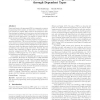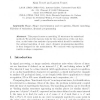172 search results - page 4 / 35 » Structure and Properties of Traces for Functional Programs |
INFSOF
1998
13 years 5 months ago
1998
Changing the internal structure of a program without changing its behavior is called restructuring. This paper presents a transformation called tuck for restructuring programs by ...
IJCAI
2003
13 years 7 months ago
2003
Disjunctive Logic Programming (DLP) is a very expressive formalism: it allows to express every property of finite structures that is decidable in the complexity class ¡£¢¤ (�...
ICFP
1999
ACM
13 years 10 months ago
1999
ACM
Functional logic languages combine the operational principles of the most important declarative programming paradigms, namely functional and logic programming. Inductively sequent...
ICFP
2009
ACM
14 years 6 months ago
2009
ACM
Functional Reactive Programming (FRP) is an approach to reactive programming where systems are structured as networks of functions operating on signals. FRP is based on the synchr...
ECCV
2000
Springer
14 years 7 months ago
2000
Springer
This paper focuses on matching 1D structures by variational methods. We provide rigorous rules for the construction of the cost function, on the basis of an analysis of properties ...


